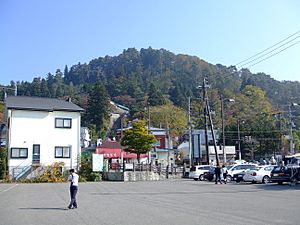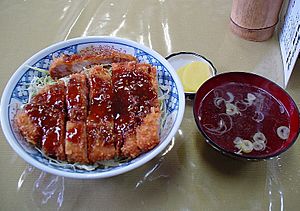Aizuwakamatsu facts for kids
Quick facts for kids
Aizuwakamatsu
会津若松市
|
|||
|---|---|---|---|

Aizuwakamatsu skyline in November 2020
|
|||
|
|||

Location of Aizuwakamatsu in Fukushima Prefecture
|
|||
| Country | Japan | ||
| Region | Tōhoku | ||
| Prefecture | Fukushima | ||
| First official recorded | 400 AD | ||
| City Settled for Wakamatsu | April 1, 1899 | ||
| Current city name changed | January 1, 1955 | ||
| Area | |||
| • Total | 382.97 km2 (147.87 sq mi) | ||
| Population
(March 1, 2020)
|
|||
| • Total | 119,232 | ||
| • Density | 311.335/km2 (806.354/sq mi) | ||
| Time zone | UTC+9 (Japan Standard Time) | ||
| – Tree | Japanese Red Pine | ||
| – Flower | Common Hollyhock | ||
| – Bird | Common cuckoo | ||
| Phone number | 0242-39-1111 | ||
| Address | 3–46 Higashisakaemachi, Aizuwakamatsu-shi, Fukushima-ken 965-8601 | ||
Aizuwakamatsu (会津若松市, Aizuwakamatsu-shi) is a city located in Fukushima Prefecture, Japan. As of January 1, 2021, about 118,159 people lived there in 50,365 homes. The city covers an area of 382.97 square kilometers (147.87 sq mi). This means there are about 310 people living in each square kilometer.
Contents
- History of Aizuwakamatsu
- Geography of Aizuwakamatsu
- Climate in Aizuwakamatsu
- Population of Aizuwakamatsu
- Economy of Aizuwakamatsu
- Education in Aizuwakamatsu
- Transportation in Aizuwakamatsu
- Media in Aizuwakamatsu
- Sister Cities of Aizuwakamatsu
- Fun Places to Visit in Aizuwakamatsu
- Culture of Aizuwakamatsu
- Famous People from Aizuwakamatsu
- See also
History of Aizuwakamatsu
The area where Aizuwakamatsu is today has been settled for a very long time. People lived here even before recorded history. For example, the Aizu-Otsuka Kofun, an ancient burial mound from the 4th century AD, is found within the city. It is considered an important cultural treasure.
Long ago, around 88 BCE, a legend says that Emperor Sujin sent two generals to this region. Their job was to bring peace after a rebellion.
Before the late 1100s, Aizuwakamatsu was mostly a market town. It was also a base for local leaders. From 1192, the city became part of the lands controlled by the Kamakura shogunate. This was a military government led by a shogun. A samurai named Suwara Yoshitsura was given control of Aizu. Later, in 1384, one of his family members, Ashina Morinori, started building the first castle in the city.
During the Sengoku period (a time of many wars in Japan), the Ashina clan lost power. In 1590, Toyotomi Hideyoshi, a powerful leader, took control. He gave Aizu to his ally, Gamo Ujisato. In 1592, Gamo Ujisato began building a new castle. It was around this time that the town was renamed "Wakamatsu," meaning "young pine."
During the Edo period (1603-1868), Aizu was ruled by different powerful families. In 1643, Hoshina Masayuki, a brother of the third Tokugawa shogun, became the ruler. The Edo period was a time of great economic and cultural growth for Aizu.
The descendants of Hoshina ruled Aizu for the next 200 years. They even adopted the Matsudaira family name. However, the last ruler, Matsudaira Katamori, supported the old government during the Boshin War. Aizuwakamatsu Castle fell during the Battle of Aizu.
After the Meiji Restoration (a big change in Japan's government), Wakamatsu Town was officially created on April 1, 1889. It became Wakamatsu City in 1899. The city grew by merging with nearby villages over the years. On January 1, 1955, Wakamatsu merged with seven more villages. At this time, its name was changed to Aizuwakamatsu. The city continued to expand in 2004 and 2005 by adding more towns and villages.
Geography of Aizuwakamatsu
Aizuwakamatsu is located in the western part of Fukushima Prefecture. It sits in the southeast part of the Aizu basin, which is like a large valley.
Mountains in Aizuwakamatsu
- Mount Ōtodake (1416 m)
- Mount Seaburi
- Mount Oda
- Mount Iimori
Rivers in Aizuwakamatsu
- Aga River
- Nippashi River
- Yugawa River
- Sesenagi River
Lakes in Aizuwakamatsu
- Lake Inawashiro
- Lake Wakasato
- Lake Higashiyama
- Lake Sohara
Hot Springs in Aizuwakamatsu
- Higashiyama Onsen
- Ashinomaki Onsen
Neighboring Cities and Towns
Aizuwakamatsu is surrounded by several other places in Fukushima Prefecture:
- North: Kitakata, Aizubange, Yugawa, Bandai
- East: Koriyama, Inawashiro
- West: Aizumisato
- South: Shimogo, Tenei
Climate in Aizuwakamatsu
Aizuwakamatsu has a climate with warm summers and cold winters. It gets a lot of snow in winter. The average temperature for the whole year is about 11.2 °C (52.2 °F). September is usually the wettest month. August is the warmest month, with temperatures around 24.7 °C (76.5 °F). January is the coldest, with temperatures around -1.2 °C (29.8 °F).
| Climate data for Aizuwakamatsu, Fukushima (1991−2020 normals, extremes 1953−present) | |||||||||||||
|---|---|---|---|---|---|---|---|---|---|---|---|---|---|
| Month | Jan | Feb | Mar | Apr | May | Jun | Jul | Aug | Sep | Oct | Nov | Dec | Year |
| Record high °C (°F) | 13.1 (55.6) |
16.1 (61.0) |
22.8 (73.0) |
30.5 (86.9) |
35.6 (96.1) |
36.4 (97.5) |
37.3 (99.1) |
38.5 (101.3) |
37.1 (98.8) |
31.3 (88.3) |
24.5 (76.1) |
20.9 (69.6) |
38.5 (101.3) |
| Mean daily maximum °C (°F) | 2.9 (37.2) |
4.0 (39.2) |
8.9 (48.0) |
16.6 (61.9) |
22.7 (72.9) |
26.0 (78.8) |
29.2 (84.6) |
30.8 (87.4) |
26.1 (79.0) |
19.5 (67.1) |
12.2 (54.0) |
5.7 (42.3) |
17.1 (62.7) |
| Daily mean °C (°F) | −0.3 (31.5) |
0.1 (32.2) |
3.7 (38.7) |
10.1 (50.2) |
16.2 (61.2) |
20.5 (68.9) |
24.0 (75.2) |
25.2 (77.4) |
20.8 (69.4) |
14.1 (57.4) |
7.4 (45.3) |
2.2 (36.0) |
12.0 (53.6) |
| Mean daily minimum °C (°F) | −3.4 (25.9) |
−3.5 (25.7) |
−0.7 (30.7) |
4.3 (39.7) |
10.3 (50.5) |
15.9 (60.6) |
20.1 (68.2) |
20.8 (69.4) |
16.6 (61.9) |
9.8 (49.6) |
3.3 (37.9) |
−0.9 (30.4) |
7.7 (45.9) |
| Record low °C (°F) | −14.4 (6.1) |
−15.2 (4.6) |
−11.9 (10.6) |
−4.6 (23.7) |
−1.2 (29.8) |
6.9 (44.4) |
9.1 (48.4) |
10.3 (50.5) |
4.8 (40.6) |
−1.5 (29.3) |
−5.9 (21.4) |
−14.4 (6.1) |
−15.2 (4.6) |
| Average precipitation mm (inches) | 102.4 (4.03) |
69.2 (2.72) |
77.5 (3.05) |
63.1 (2.48) |
75.8 (2.98) |
108.6 (4.28) |
196.4 (7.73) |
139.1 (5.48) |
124.0 (4.88) |
112.6 (4.43) |
75.5 (2.97) |
108.7 (4.28) |
1,252.9 (49.31) |
| Average snowfall cm (inches) | 121 (48) |
90 (35) |
41 (16) |
3 (1.2) |
0 (0) |
0 (0) |
0 (0) |
0 (0) |
0 (0) |
0 (0) |
1 (0.4) |
72 (28) |
328 (128.6) |
| Average precipitation days (≥ 0.5 mm) | 19.0 | 16.1 | 16.6 | 12.0 | 11.4 | 12.2 | 15.2 | 12.6 | 12.4 | 12.4 | 15.1 | 18.3 | 173.3 |
| Average snowy days | 27.6 | 23.8 | 17.5 | 4.1 | 0.0 | 0.0 | 0.0 | 0.0 | 0.0 | 0.1 | 7.0 | 22.4 | 102.5 |
| Average relative humidity (%) | 82 | 79 | 74 | 67 | 67 | 73 | 79 | 77 | 79 | 80 | 83 | 84 | 77 |
| Mean monthly sunshine hours | 78.0 | 99.0 | 144.0 | 172.0 | 201.2 | 165.3 | 156.9 | 195.1 | 141.8 | 122.1 | 89.1 | 67.1 | 1,631.6 |
| Source 1: Japan Meteorological Agency | |||||||||||||
| Source 2: Japan Meteorological Agency (records) | |||||||||||||
Population of Aizuwakamatsu
The number of people living in Aizuwakamatsu grew until around 1990. Since then, the population has slowly gone down to levels seen before 1960.
| Historical population | ||
|---|---|---|
| Year | Pop. | ±% |
| 1950 | 115,578 | — |
| 1960 | 119,402 | +3.3% |
| 1970 | 120,839 | +1.2% |
| 1980 | 130,883 | +8.3% |
| 1990 | 136,336 | +4.2% |
| 2000 | 135,415 | −0.7% |
| 2010 | 126,125 | −6.9% |
| 2020 | 117,376 | −6.9% |
Economy of Aizuwakamatsu
Aizuwakamatsu is an important business hub for the local area. The city is well-known for making sake (Japanese rice wine) and beautiful lacquerware. Today, other important industries include making textiles (like cloth), processing wood, and producing electronics.
Education in Aizuwakamatsu
Aizuwakamatsu has a university and a junior college. The city also has many public elementary and junior high schools. There are also private schools. For older students, Fukushima Prefecture runs five public high schools.
Universities and Colleges
- University of Aizu
- Junior College of Aizu
High Schools
- Aizu High School
- Aoi High School
- Aizu Gakuhō High School
- Wakamatsu Shōgyō High School
- Aizu Kōgyō High School
- Aizu Second High School
- Aizuwakamatsu Xaverio Gakuen High School (Private)
- Wakamatsu 1st High School (Private)
- Jinai High School (Private)
Junior High Schools
- Aizuwakamatsu First Junior High School
- Aizuwakamatsu Second Junior High School
- Aizuwakamatsu Third Junior High School
- Aizuwakamatsu Fourth Junior High School
- Aizuwakamatsu Fifth Junior High School
- Aizuwakamatsu Sixth Junior High School
- Ikki Junior High School
- Ōto Junior High School
- Minato Junior High School
- Kitaaizu Junior High School
- Kawahigashi Junior High School
- Aizu Gakuhō Junior High School (Prefectural)
- Aizuwakamatsu Xaverio Gakuen Junior High School (Private)
Transportation in Aizuwakamatsu
You can travel to and from Aizuwakamatsu by train, highway, and bus.
Train Lines
Highways
 Ban-etsu Expressway
Ban-etsu Expressway National Route 49
National Route 49 National Route 118
National Route 118 National Route 121
National Route 121 National Route 252
National Route 252 National Route 294
National Route 294 National Route 401
National Route 401
Bus Services
- Aizu Bus
Media in Aizuwakamatsu
Aizuwakamatsu has local TV stations, newspapers, and radio stations that keep residents informed.
Television Stations
- NHK Fukushima
- Fukushima Television Broadcasting
- Fukushima Central Television
- Fukushima Broadcasting
- TV-U Fukushima
Newspapers
- Fukushima Mimpō
- Fukushima Min-Yū
Radio Stations
- FM Aizu
Sister Cities of Aizuwakamatsu
Aizuwakamatsu has special partnerships with other cities, both in Japan and around the world. These are called "sister cities."
Japanese Sister Cities
 Mutsu, Aomori, since 1984
Mutsu, Aomori, since 1984 Naruto, Tokushima, since 1999
Naruto, Tokushima, since 1999 Ina, Nagano, since 2000
Ina, Nagano, since 2000 Yokosuka, Kanagawa, since 2005
Yokosuka, Kanagawa, since 2005
International Sister Cities
Fun Places to Visit in Aizuwakamatsu
Aizuwakamatsu has many interesting places to explore, especially if you like history and nature.
- Aizuwakamatsu Castle (also known as Tsuruga-jo)
- Aizu Matsudaira's Royal Garden (Oyakuen)
- Mount Iimori, where you can find:
- Graves of the Byakkotai (a group of young samurai)
- Sazaedo (a unique wooden temple)
- Former Takizawa Honjin (a special inn for feudal lords)
- Aizu Matsudaira clan grave
- Nisshinkan (a historical school for samurai children)
- Aizu Samurai Residences (a village showing samurai life)
- Nanukamachi-dori Street (a historic street with old shops)
Culture of Aizuwakamatsu
Aizuwakamatsu has a rich culture, with special festivals, unique foods, and traditional crafts.
Festivals
- Aizu Festival
Foods to Try
- Kozuyu (a local soup)
- Sauce Katsu-don (a rice bowl with fried pork cutlet and special sauce)
- Basashi (horse sashimi - thinly sliced raw horse meat)
- Soba (buckwheat noodles)
- Boutara (dried codfish)
- Sake (Japanese rice wine)
Traditional Crafts and Symbols
- Akabeko (a red cow toy, a symbol of good luck)
- Okiagari-koboshi (a roly-poly doll that always stands up, symbolizing perseverance)
Famous People from Aizuwakamatsu
Many notable people have come from Aizuwakamatsu:
- Wakashima Kyūzaburō (1842–1891), a famous sumo wrestler
- Kei Satō (1928–2010), an actor and narrator
- Hiroshi Sasagawa (1936–), an anime creator
- Sōichirō Hoshi (1972–), a voice actor
- Aya Ohori (1996–), a Japanese badminton player
See also
 In Spanish: Aizuwakamatsu (Fukushima) para niños
In Spanish: Aizuwakamatsu (Fukushima) para niños











